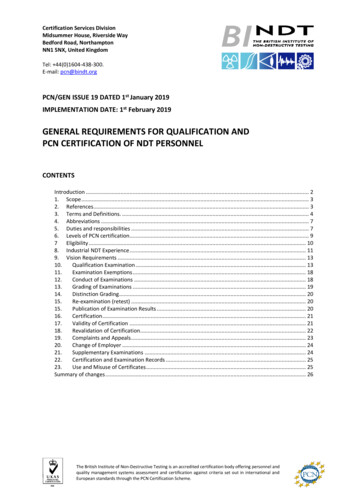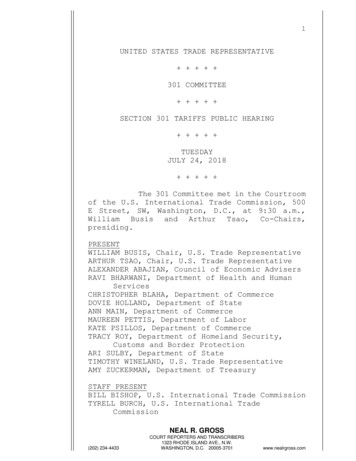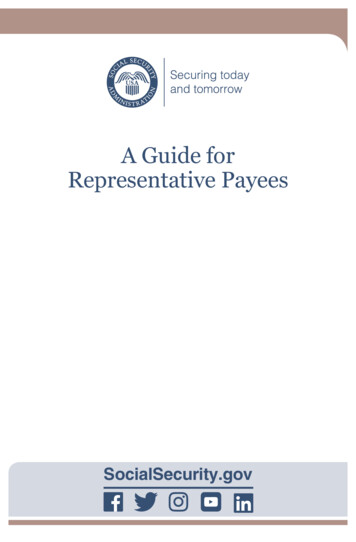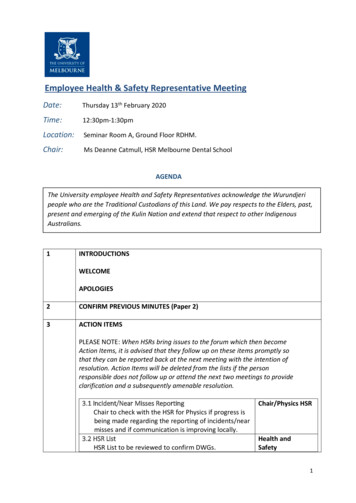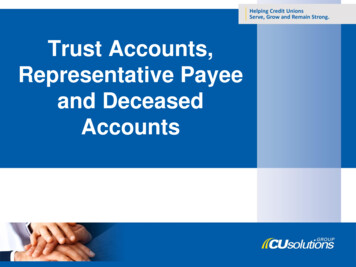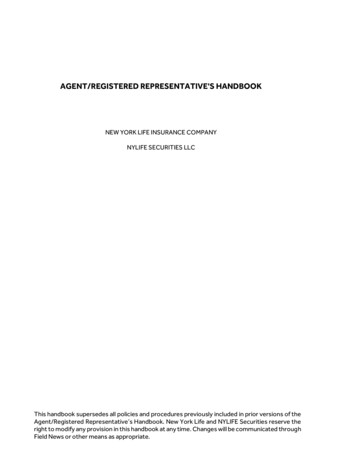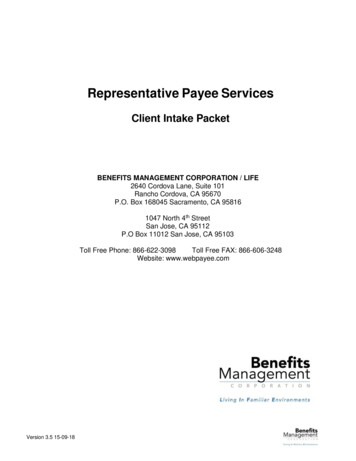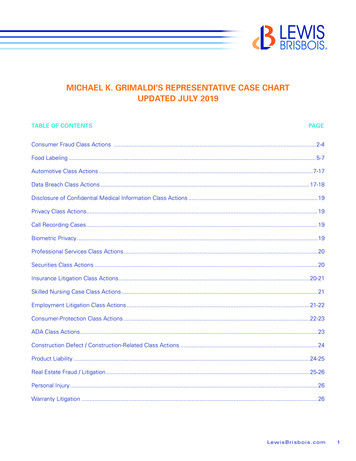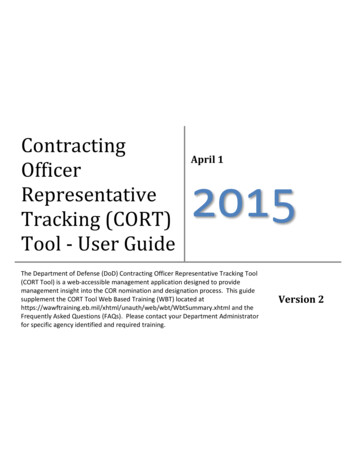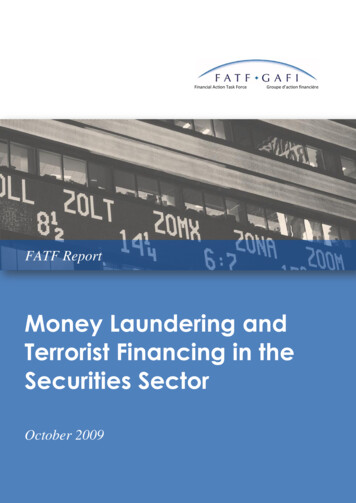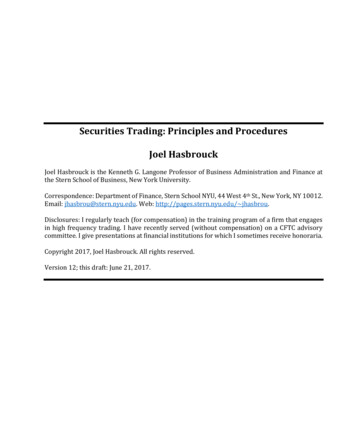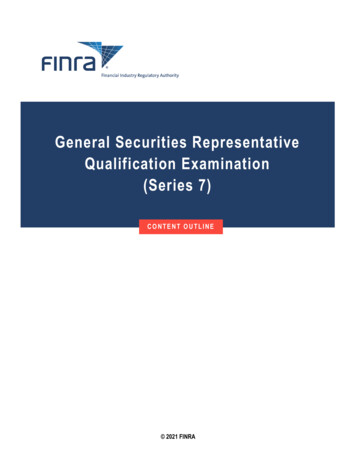
Transcription
General Securities RepresentativeQualification Examination(Series 7)CONTENT OUTLINE 2021 FINRA
Series 7PURPOSE OF THE EXAMThe Series 7 exam is designed to assess the competency of entry-level General Securities Representatives. TheSeries 7 exam seeks to measure the degree to which each candidate possesses the knowledge, skills and abilitiesneeded to perform the critical functions of a General Securities Registered Representative. In order to obtainregistration as a General Securities Representative, candidates must pass both the Series 7 exam and a generalknowledge co-requisite, the Securities Industry Essentials (SIE) exam. For more information about the activitiesrequiring registration as a General Securities Representative, see FINRA Rule 1220(b)(2).STRUCTURE OF THE EXAMThe exam consists of 125 multiple-choice items, and each item consists of four answer choices. The allocation ofexam items for each major function is as follows:Function1234DescriptionSeeks Business for the Broker-Dealer fromCustomers and Potential CustomersOpens Accounts After Obtaining and EvaluatingCustomers’ Financial Profile and InvestmentObjectivesProvides Customers with Information AboutInvestments, Makes Recommendations, TransfersAssets and Maintains Appropriate RecordsObtains and Verifies Customers’ Purchase and SalesInstructions and Agreements; Processes, Completesand Confirms TransactionsTOTALPercentage ofExam ItemsNumber of Items7%99%1173%9111%14100%125ADMINISTRATION OF THE EXAMThe exam is administered via computer. A tutorial on how to take the exam is provided prior to taking the exam. Eachcandidate’s exam includes 10 additional, unidentified pretest items that do not contribute toward the candidate'sscore. The pretest items are randomly distributed throughout the exam. Therefore, each candidate’s exam consists ofa total of 135 items (125 scored and 10 unscored). There is no penalty for guessing. Therefore, candidates shouldattempt to answer all items. Candidates will be allowed 3 hours and 45 minutes to complete the Series 7 exam.All candidate test scores are placed on a common scale using a statistical adjustment process known as equating.Equating scores to a common scale accounts for the slight variations in difficulty that may exist among the differentsets of exam items that candidates receive. This allows for a fair comparison of scores and ensures that everycandidate is held to the same passing standard regardless of which set of exam items they received.Candidates are not permitted to bring reference materials to their testing session. Severe penalties are imposed oncandidates who cheat or attempt to cheat on FINRA-administered exams.Please visit www.finra.org for additional details.2
Series 7Function 1: Seeks Business for the Broker-Dealer from Customers and PotentialCustomers1.1Contacts current and potential customers in person and by telephone, mail and electronicmeans; develops promotional and advertising materials and seeks appropriate approvals todistribute marketing materialsKnowledge of: Standards and required approvals of public communications Types of communications (e.g., retail, institutional, correspondence) Seminars, lectures and other group forum requirements Product specific advertisements and disclosures Investment company products and variable contracts Options-related communications; options disclosure document (ODD) Municipal securities Research reports (e.g., quiet periods, distribution, third-party research) Government securities, collateralized mortgage obligations (CMOs), certificates of deposit (CDs)FINRA Rules2210 – Communications with the Public2211 – Communications with the Public about Variable Life Insurance and Variable Annuities2212 – Use of Investment Companies Rankings in Retail Communications2213 – Requirements for the Use of Bond Mutual Fund Volatility Ratings2216 – Communications with the Public about Collateralized Mortgage Obligations (CMOs)2220 – Options Communications2330 – Members’ Responsibilities Regarding Deferred Variable Annuities2360 – OptionsSEC Rules and RegulationsSecurities Act of 1933Section 5 – Prohibitions Relating to Interstate Commerce and the Mails156 – Investment Company Sales Literature482 – Advertising by an Investment Company as Satisfying Requirements of Section 10498 – Summary Prospectuses for Open-End Management Investment CompaniesSecurities Exchange Act of 193415c2-12 – Municipal Securities Disclosure15c3-3 – Customer Protection — Reserves and Custody of SecuritiesCboe Rules9.8 – Addressing of Communications to Customers9.9 – Delivery of Current Options Disclosure Documents9.15 – Options CommunicationsMSRB RuleG-21 – Advertising1.2Describes investment products and services to current and potential customers with theintent of soliciting business3
Series 7Knowledge of: Process for bringing new issues to market (e.g., due diligence, registration statement, preliminaryprospectus, final prospectus, underwriting agreement, selling group agreement, blue-sky laws andprocedures) Regulatory requirements for initial public offerings (IPOs) (e.g., restrictions on prospecting or soliciting,allowable communications with the public) Primary financing for municipal securities (e.g., competitive sale, negotiated sale, private offering, advancerefunding) Syndicate formation and operational procedures (e.g., purpose of syndicate bid, roles and responsibilities ofunderwriters, selling group concession and reallowance) Pricing practices and components of underwriters’ spread and determination of underwriters’ compensationand selling practices Prospectus requirements (e.g., timeliness of information, preliminary prospectus (red herring), finalprospectus) Information required in a registration statement and offering material on new issue (e.g., in pre-filing period,in cooling-off period, in post-registration period) Official statements, preliminary official statements, notice of sale for municipal securities Qualified institutional buyer (QIB) and accredited investor Qualification requirements for Regulation A offerings (e.g., filing of abbreviated registration statement andoffering circular Regulation D offerings (e.g., exemption from SEC registration, access to capital markets, accreditedinvestors) Securities and transactions exempted from registration, including Section 3(a)(11) of the Securities Act of1933 and Rule 147 thereunder (i.e., intrastate offering) Regulatory requirements for private placements or resales Nonregistered foreign securities sold to institutions qualified in the U.S. Foreign securities prohibited from being sold to U.S. investorsFINRA Rules3160 – Networking Arrangements Between Members and Financial Institutions3170 – Tape Recording of Registered Persons by Certain Firms5110 – Corporate Financing Rule — Underwriting Terms and Arrangements5121 – Public Offerings of Securities with Conflicts of Interest5130 – Restrictions on the Purchase and Sale of Initial Equity Public Offerings5131 – New Issue Allocations and Distributions5141 – Sale of Securities in a Fixed Price Offering5160 – Disclosure of Price and Concessions in Selling Agreements5190 – Notification Requirements for Offering ParticipantsSEC Rules and RegulationsSecurities Act of 1933Section 3 – Exempted SecuritiesSection 4 – Exempted Transactions134 – Communications Not Deemed a Prospectus134a – Options Material Not Deemed a Prospectus144 – Persons Deemed Not To Be Engaged in a Distribution and Therefore Not Underwriters144A – Private Resales of Securities to Institutions145 – Reclassification of Securities, Mergers, Consolidations and Acquisitions of Assets147 – Intrastate Offers and Sales164 – Post-filing Free Writing Prospectuses in Connection with Certain Registered Offerings4
Series 7Securities Exchange Act of 193410b-1 – Prohibition of Use of Manipulative or Deceptive Devices or Contrivances with Respect toCertain Securities Exempted from Registration10b-3 – Employment of Manipulative and Deceptive Devices by Brokers or Dealers10b-18 – Purchases of Certain Equity Securities by the Issuer and Others15c2-8 – Delivery of Prospectus17a-3 – Records To Be Made by Certain Exchange Members, Brokers and DealersRegulation A – Conditional Small Issues ExemptionRegulation C – Registration415 – Delayed or Continuous Offering and Sale of Securities427 – Contents of Prospectus Used After Nine Months430 – Prospectus for Use Prior to Effective Date430A – Prospectus in a Registration Statement at the Time of Effectiveness430B – Prospectus in a Registration Statement After Effective Date433 – Conditions to Permissible Post-filing Free Writing ProspectusesRegulation D – Rules Governing the Limited Offer and Sale of Securities Without Registration Under theSecurities Act of 1933500 – Use of Regulation D501 – Definitions and Terms Used in Regulation D502 – General Conditions to be Met503 – Filing of Notice of Sale504 – Exemption for Limited Offerings and Sales of Securities Not Exceeding 5,000,000506 – Exemption for Limited Offers and Sales Without Regard to Dollar Amount of Offering507 – Disqualifying Provision Relating to Exemptions under Rules 504 and 506508 – Insignificant Deviations from a Term, Condition or Requirement of Regulation DRegulation MRegulation S – Rules Governing Offers and Sales Made Outside the United States Without RegistrationUnder the Securities Act of 1933Trust Indenture Act of 1939MSRB RulesG-11 – Primary Offering PracticesG-28 – Transactions with Employees and Partners of Other Municipal Securities ProfessionalsG-32 – Disclosures in Connection with Primary OfferingsG-34 – CUSIP Numbers, New Issue, and Market Information RequirementsG-38 – Solicitation of Municipal Securities Business5
Series 7Function 2: Opens Accounts After Obtaining and Evaluating Customers’ FinancialProfile and Investment Objectives2.1Informs customers of the types of accounts and provides disclosures regarding variousaccount types and restrictionsKnowledge of: Types of accounts (e.g., pattern day trading, prime brokerage, delivery verses payment/receive versuspayment (DVP/RVP), advisory or fee-based) Account registration types (e.g., tenants in common (TIC), community property, sole proprietorship,partnership, unincorporated associations) Requirements for opening customer accounts Retirement plans and other tax advantaged accounts Transfers, rollovers, eligibility, distribution strategies and taxation (e.g., types of allowable contributions,distribution options, taxation of distribution at retirement, age restrictions for distributions, permissibleinvestments) Employer-sponsored plans and ERISA (e.g., 457, defined benefit, profit-sharing, stock options andstock purchase, non-qualified deferred compensation programs) Wealth events (e.g., inheritance) Account registration changes and internal transfersFINRA Rules2270 – Day-trading Risk Disclosure Statement2130 – Approval Procedures for Day-trading Accounts4512 – Customer Account Information4514 – Authorization Records for Negotiable Instruments Drawn from a Customer’s Account4515 – Approval and Documentation of Changes in Account Name or DesignationCboe Rule9.1 – Opening of AccountsInternal Revenue Code219 – Retirement Savings415 – Limitations on Benefits and Contributions Under Qualified Plans529 – Qualified Tuition Programs530 – Coverdell Education Savings AccountsEmployee Retirement Income Security Act of 1974 (ERISA)2.2Obtains and updates customer information and documentation, including required legaldocuments and identifies and escalates suspicious activityKnowledge of: Customer screening (e.g., customer identification program (CIP), know-your-customer (KYC), domestic orforeign residency and/or citizenship, corporate insiders, employees of broker-dealers or self-regulatoryorganizations (SROs)) Information security and privacy regulations (e.g., initial privacy disclosures to customers, opt-out notices,disclosure limitations, exceptions)6
Series 7 Account authorizations (e.g., power of attorney (POA), trust documents, corporate resolutions, tradingauthority, discretionary account documents)FINRA Rule408T – Discretionary Power in Customers’ Accounts2090 – Know Your Customer3260 – Discretionary AccountsSEC Rules and RegulationsSecurities Exchange Act of 1934Section 3(a)(35) – Definitions and Application of Title – “Investment Discretion”Regulation S-P – Privacy of Consumer Financial Information and Safeguarding Personal InformationCboe Rule9.4 – Discretionary Accounts2.3Makes reasonable efforts to obtain customer investment profile information including, butnot limited to, the customer's other security holdings, financial situation and needs, taxstatus and investment objectivesKnowledge of: Essential facts regarding customers and customer relationships Financial factors relevant to assessing a customer’s investment profile Security holdings, other assets and liabilities, annual income, net worth, tax considerations Other considerations (e.g., age, marital status, dependents, employment, investment experience, homeownership and financing, employee stock options, insurance, liquidity needs) Investment objectives (e.g., preservation of capital, income, growth, speculation) Reasonable-basis, customer-specific and quantitative care obligations Investment strategies and recommendations to hold Verification of investor accreditation and sophisticationFINRA Rules2111 – Suitability2214 – Requirements for the Use of Investment Analysis ToolsSEC Rules and RegulationsSecurities Act of 193415l-1 – Regulation Best InterestMSRB RuleG-19 – Suitability of Recommendations and Transactions2.4Obtains supervisory approvals required to open accountsKnowledge of: Required review, approvals and documentation for account opening and maintenance Physical receipt, delivery and safeguarding of cash or cash equivalents, checks and securities Circumstances for refusing or restricting activity in an account or closing accountsFINRA Rules7
Series 73110 – Supervision3120 – Supervisory Control SystemCboe Rule9.2 – Supervision of AccountsMSRB RuleG-27 – Supervision8
Series 7Function 3: Provides Customers with Information About Investments, MakesRecommendations, Transfers Assets and Maintains Appropriate Records3.1Provides customers with information about investment strategies, risks and rewards, andcommunicates relevant market, investment and research data to customersKnowledge of: Customer-specific factors that generally affect the selection of securities (i.e., customer’s investment profile,including the customer’s risk tolerance, investment time horizon and investment objectives, liquidity needs) Portfolio or account analysis and its application to security selection (e.g., diversification, asset allocationprinciples, concentration, volatility, potential tax ramifications) Portfolio theory (e.g., alpha and beta considerations, Capital Asset Pricing Model (CAPM)) Delivery of annual reports and notices of corporate actions (e.g., dividends, splits, odd lot tenders) Fundamental analysis of financial statements and types of financial statements included in an annual report,importance of footnotes, material risk disclosures and key terms (e.g., assets, liabilities, capital, cash flow,income, earnings per share (EPS), book value, shareholders' equity, depreciation, depletion, goodwill) Balance sheet and methods of inventory valuation: last-in, first out (LIFO), first-in, first-out (FIFO) andmethods of depreciation Income statement and calculations derived from an income statement: earnings before interest and taxes(EBIT); earnings before taxes (EBT); net profit; and earnings before interest, taxes, depreciation andamortization (EBITDA) Principal tools to measure financial health Liquidity: working capital, current ratio, quick assets, acid test ratio Risk of bankruptcy: bond ratio, debt-to-equity ratio Efficient use of assets: inventory turnover ratio, cash flow Profitability: margin-of-profit ratio, net profit ratio, asset coverage and safety of income (i.e., net assetvalue (NAV) per bond, bond interest coverage, book value per share) EPS: fully diluted EPS, price-earnings (P/E) ratio, dividend payout ratio, current yield Competitiveness (comparative performance): return on common equitySEC Rules and RegulationsSecurities Exchange Act of 193414e-3 – Transactions in Securities on the Basis of Material, Nonpublic Information in the Context ofTender Offers14e-4 – Prohibited Transactions in Connection with Partial Tender OffersCboe Rule9.3 – Suitability of Recommendations3.2Reviews and analyzes customers' investment profiles and product options to determine thatinvestment recommendations meet applicable standardsKnowledge of:Equity securities Types of stock (e.g., authorized, issued, outstanding, Treasury stock, stated value) Characteristics of common stock Rights of common stockholders (e.g., pre-emptive right, pro rata share of dividends, access tocorporate books, voting power (statutory, cumulative, nonvoting), residual claims on corporate assets) Spinoffs9
Series 7 Stock acquired through a consolidation or transfer Penny stocks and rules associated with penny stock transactionsCharacteristics of preferred stock Types of preferred stock (e.g., cumulative, non-cumulative, participating, nonparticipating, convertible,callable, adjustable-rate and variable-rate) Rights of preferred stockholders (e.g., preference upon corporate dissolution, dividend payment,conversions, sinking fund provisions)Rights and warrants: origination, exercise terms, relationship of subscription price to market price ofunderlying stock, anti-dilution agreementElectronic exchanges or auction markets (e.g., electronic communications networks (ECNs), over-thecounter (OTC), dark pools of liquidity)Types and characteristics of non-U.S. market securities (e.g., American Depositary Receipts (ADRs),corporate equity)Tax treatment of equity securities transactions Capital gains and losses, dividend distributions (qualified and non-qualified), wash sales, holdingperiods Determination of net long-term and short-term gains or losses When-issued securities, securities acquired through conversion Calculation of cost basis per share on: purchases, exchange of convertibles for common shares, stockdividends and stock rights, inherited or gifted securities Cost valuation: FIFO, LIFO, identified sharesPackaged products Investment companies, exchange-traded funds (ETFs), unit investment trusts (UITs) Types of mutual funds: equity, fixed income, money market, interval Structure of investment companies (e.g., open-end and closed-end funds) Fund objectives (e.g., value, growth, income, balanced, international, sector, life cycle) Characteristics of: Open-end funds: e.g., NAV, forward pricing, offering price, exchange privileges within families offunds, fees and expenses: no load, load (front-end, back-end), distribution fees, management fees,nature of 12b-1 fees Closed-end funds: distributed in primary market at IPO price, traded in secondary market Sales practices (e.g., dollar-cost averaging (DCA), computing sales charge, breakpoints) Redemption (e.g., redemption price, payout or withdrawal plans, conversion privilege, restrictions,contingent deferred sales charge, tenders) Tax treatment of mutual funds Reinvestment of dividends and capital gain distributions Charges and expenses Variable life insurance/annuity contracts Characteristics and insurance features (e.g., minimum guarantees, death benefits, living benefits,riders) Separate accounts (e.g., purpose, management of portfolio, investment policies, performance ofaccount) Valuation of a variable annuity contract (e.g., accumulation units, surrender value, annuitization units) Purchasing or exchanging variable annuities (e.g., immediate annuity, charges, fees, penalties, right ofaccumulation (ROA), waiver of premium) Annuitization: types of election, variable pa
Seeks Business for the Broker-Dealer from Customers and Potential Customers 7% 9 2 Opens Accounts After Obtaining and Evaluating Customers’ Financial Profile and Investment Objectives 9% 11 3 Provides Customers with Information About Investments, Makes Recommendations, Tr
